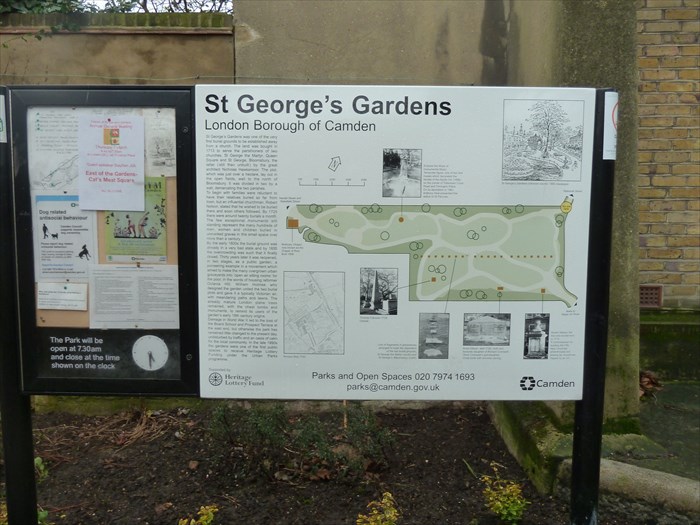This area appears to be well maintained as a green space, but the remaining crypts and monuments are mostly illegible, at least one completely broken (apparently by vandals), and other headstones are merely set against a wall, again largely unidentifiable. The terracotta statue of Euterpe, the muse of instrumental music, which was placed here is now missing its right hand. An image of the intact statue can be found at
Friends of St. George's Gardens.

St. George's Gardens
London Borough of Camden
St. George's Gardens was one of the very first burial grounds to be established away from a church. The land was bought in 1713 to serve the parishioners of two churches, St. George the Martyr, Queen Square and St. George, Bloomsbury, the latter (still then unbuilt) by the great architect Nicholas Hawksmoor. The plot which was just over a hectare, lay out in the open fields, well to the north of Bloomsbury. It was divided in two by a wall, demarcating the two parishes. To begin with families were reluctant to have their relatives buried so far from town, but an influential churchman, Robert Nelson, stated that he wished to be buried there and soon others followed. By 1725 there were around twenty burials a month. The few exceptional monuments still standing represent the many hundreds of men, women and children buried in
unmarked graves in this small space over more than a century.
By the early 1800s the burial ground was already in a very bad state and by 1855 the overcrowding was such that it finally closed. Thirty years later it was reopened, in two stages, as a public garden, a pioneering example in a movement which aimed to make the many overgrown urban graveyards into open air sitting rooms for the poor, in words of housing reformer Octavia Hill. William Holmes who designed the garden united the two burial plots and gave it a typically Victorian air, with meandering paths and lawns. The already mature London plane trees remained with the chest tombs and monuments, to remind its users of the garden's early 18th century origins.
Damage in World War II led to the loss of the Board School and Prospect Terrace at the east end, but otherwise the park has remained little changed to the present day, undisturbed by traffic and an oasis of calm for the local community. In the late 1990s the gardens were one of the first public spaces to receive Heritage Lottery Funding under the Urban Parks programme.
(Listed objects pictured on the map)
* Robert Nelson, the first man buried here in 1715. A Commissioner for building the Fifty New Churches, philanthropist and leading lay churchman. Topped by an art urn.
* Anna Gibson, died 1726, sixth and favourite daughter of Richard Cromwell, Oliver Cromwell's grandaughter. Chest tomb with armorial carving.
* Thomas Falconer 1729. Obelisk.
* Euterpe the Muse of Instrumental Music. Terracotta figure, one of the nine muses which decorated the facade of the Apollo Inn (1898) on the corner of Tottenham Court Road and Torrington Place. On its demolition in 1961, Anthony Heal presented this statue to St. Pancras.
* Line of fragments of gravestones arranged to mark the separation of the two burial grounds. St. George the Martyr (south) and St. George's Bloombury (north).
[See photo gallery for more images.]